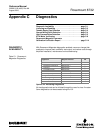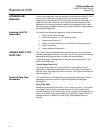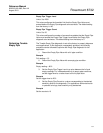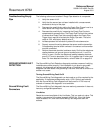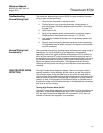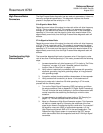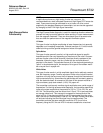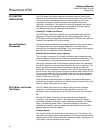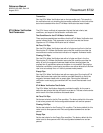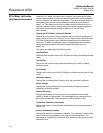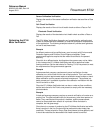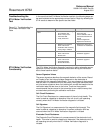
Reference Manual
00809-0100-4665, Rev AA
August 2010
Rosemount 8732
C-6
High Process Noise
Parameters
The High Process Noise diagnostic has two read-only parameters. It does not
have any configurable parameters. This diagnostic requires that flow be
present in the pipe and the velocity be > 1 ft/s.
5 Hz Signal to Noise Ratio
Reads the current value of the signal to noise ratio at the coil drive frequency
of 5 Hz. This is a read-only value. This number is a measure of the signal
strength at 5 Hz relative to the amount of process noise. If the transmitter is
operating in 5 Hz mode, and the signal to noise ratio remains below 25 for
approximately one minute, then the High Process Noise diagnostic alert will
activate.
37 Hz Signal to Noise Ratio
Reads the current value of the signal to noise ratio at the coil drive frequency
of 37 Hz. This is a read-only value. This number is a measure of the signal
strength at 37 Hz relative to the amount of process noise. If the transmitter is
operating in 37 Hz mode, and the signal to noise ratio remains below 25 for
approximately one minute, then the High Process Noise diagnostic alert will
activate.
Troubleshooting High
Process Noise
The transmitter detected high levels of process noise. If the signal to noise
ratio is less than 25 while operating in 5 Hz mode, proceed with the following
steps:
1. Increase transmitter coil drive frequency to 37 Hz (refer to “Coil Drive
Frequency” on page 4-13) and, if possible, perform Auto Zero
function (refer to “Auto Zero” on page 4-12).
2. Verify sensor is electrically connected to the process with grounding
electrode, grounding rings with grounding straps, or lining protector
with grounding straps.
3. If possible, redirect chemical additions downstream of the magmeter.
4. Verify process fluid conductivity is above 10 microsiemens/cm.
If the signal to noise ratio is less than 25 while operating in 37 Hz mode,
proceed with the following steps:
1. Turn on the Digital Signal Processing (DSP) technology and follow
the setup procedure (refer to Appendix D: Digital Signal Processing).
This will minimize the level of damping in the flow measurement and
control loop while also stabilizing the reading to minimize valve
actuation.
2. Increase damping to stabilize the signal (refer to “PV Damping” on
page 3-11). This will add dead-time to the control loop.
3. Move to a Rosemount High-Signal flowmeter system. This flowmeter
will deliver a stable signal by increasing the amplitude of the flow
signal by ten times to increase the signal to noise ratio. For example if
the signal to noise ratio (SNR) of a standard magmeter is 5, the
High-Signal would have a SNR of 50 in the same application. The
Rosemount High-Signal system is comprised of the 8707 sensor
which has modified coils and magnetics and the 8712H High-Signal
transmitter.






